Building the system 'Sunglacier' creates ice in desert conditions
Dutch engineers work at Cofely, a company that designs ice rinks and frozen storage systems for food, creating a 10cm-thick ice sheet on an aluminum surface inside a shipping container. transfer, simulate conditions in the desert at a temperature of about 30 o C. This is one of these tests that is part of the "Sunglacier" system construction project currently undergoing preliminary testing in the Netherlands.
The project to build "Sunglacier" system , including solar photovoltaic panels covered on the surface of about 200m 2 , will provide cooling power for condensing devices (integrated on the underside of the structure). Swing leaves structure to absorb moisture from the air in the desert and turn it into frozen water.
"The results of this study have demonstrated that dealing with climate change is entirely feasible , " said Ap Verheggen, who participated in the study.
This project works on the basic principles of condensation . We believe that the higher the humidity in the air, the more free water we create, according to Jan Alkemaide, the project's leading engineer.

Although the Desert is famous for being dry, Verheggen said : "The results of our study in Egypt have shown that: The Sahara contains the same amount of moisture in the air as in the Netherlands." .
In this test, the Sunglacier system also includes a humidifier to provide humidity and a fan to simulate desert winds.
Puddles form below the Sunglacier system as a result of the ice process (including thick ice) melted at high temperatures in the desert.
"Theoretically, the conditions of warmer air can produce more ice and the plan is to increase the test temperature to 50ºC , " Verheggen said.
Alkemaide explains that the goal of Sunglacier system is to create 1m 2 of ice for every 10m 2 of solar photovoltaic panels. However, this will be difficult because flexible solar photovoltaic panels are not as effective as conventional flat solar photovoltaic panels.
"In other words, we need to generate 1kW of solar energy from 2kW of thermal energy transported from the surface to the atmosphere. However, we still need to create 1kW of solar energy for 1kW of heat. The ability, therefore, that we are unable to achieve our goals , " according to Alkemaide, this shows that the current Sunglacier system is still incomplete.
Once the tests were completed in 2012, Verheggen planned to build a Sunglacier system to perform in the desert as a way to inspire people to demonstrate that coping with climate change is what absolute possible.
- Build miniature solar system in the desert
- Building a huge lake system in the desert
- Al Fayah - The park is built beneath the desert
- Simulation of Mars environment on rock desert
- The most exotic deserts in the world
- The largest desert - desert in the world (1)
- Snow falls over the Sahara
- Devilish thorns suck water from desert sand
- China built a mysterious building in the desert
- How are different deserts and deserts?
- Israeli researchers prepare for life on Mars
- Japan develops technology to help roots grow three times faster
 Vietnam 5th Asian champion on fuel-efficient vehicles
Vietnam 5th Asian champion on fuel-efficient vehicles We can read all NASA studies completely free of charge
We can read all NASA studies completely free of charge Singer and songwriter Bob Dylan won the 2016 Nobel Prize for Literature
Singer and songwriter Bob Dylan won the 2016 Nobel Prize for Literature Scientific revolution in Asia
Scientific revolution in Asia Malaysia has joined the Antarctic Treaty
Malaysia has joined the Antarctic Treaty  Cosmic cooperation with China is controversial in the United States
Cosmic cooperation with China is controversial in the United States  Add 3 new elements in the periodic table
Add 3 new elements in the periodic table  Solar battery factory begs appointment with Vietnam
Solar battery factory begs appointment with Vietnam  Iran moved nuclear devices to the ground
Iran moved nuclear devices to the ground  UNESCO honors five outstanding female scientists
UNESCO honors five outstanding female scientists 